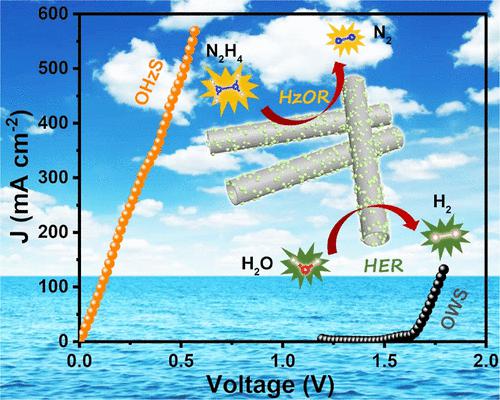当前位置:
X-MOL 学术
›
ACS Appl. Mater. Interfaces
›
论文详情
Our official English website, www.x-mol.net, welcomes your
feedback! (Note: you will need to create a separate account there.)
Robust and Highly Efficient Electrochemical Hydrogen Production from Hydrazine-Assisted Water Electrolysis Enabled by the Metal–Support Interaction of Ru/C Composites
ACS Applied Materials & Interfaces ( IF 8.3 ) Pub Date : 2023-05-24 , DOI: 10.1021/acsami.3c04342 Wentao Wang 1 , Qizhu Qian 2, 3 , Yapeng Li 3 , Yin Zhu 3 , Yafei Feng 3 , Mingyu Cheng 3 , Huaikun Zhang 3 , Yangyang Zhang 3 , Genqiang Zhang 2, 3
ACS Applied Materials & Interfaces ( IF 8.3 ) Pub Date : 2023-05-24 , DOI: 10.1021/acsami.3c04342 Wentao Wang 1 , Qizhu Qian 2, 3 , Yapeng Li 3 , Yin Zhu 3 , Yafei Feng 3 , Mingyu Cheng 3 , Huaikun Zhang 3 , Yangyang Zhang 3 , Genqiang Zhang 2, 3
Affiliation

|
Hydrazine oxidation-assisted water electrolysis provides a promising way for the energy-efficient electrochemical hydrogen (H2) and synchronous decomposition of hydrazine-rich wastewater, but the development of highly active catalysts still remains a great challenge. Here, we demonstrate the robust and highly active Ru nanoparticles supported on the hollow N-doped carbon microtube (denoted as Ru NPs/H-NCMT) composite structure as HER and HzOR bifunctional electrocatalysts. Thanks to such unique hierarchical architectures, the as-synthesized Ru NPs/H-NCMTs exhibit prominent electrocatalytic activity in the alkaline condition, which needs a low overpotential of 29 mV at 10 mA cm–2 for HER and an ultrasmall working potential of −0.06 V (vs RHE) to attain the same current density for HzOR. In addition, assembling a two-electrode hybrid electrolyzer using as-prepared Ru NPs/H-NCMT catalysts shows a small cell voltage of mere 0.108 V at 100 mA cm–2, as well as the remarkable long-term stability. Density functional theory calculations further reveal that the Ru NPs serve as the active sites for both the HER and HzOR in the nanocomposite, which facilitates the adsorption of H atoms and hydrazine dehydrogenation kinetics, thus enhancing the performances of HER and HzOR. This work paves a novel avenue to develop efficient and stable electrocatalysts toward HER and HzOR that promises energy-saving hybrid water electrolysis electrochemical H2 production.
中文翻译:

Ru/C 复合材料的金属-载体相互作用支持肼辅助水电解稳健高效的电化学制氢
肼氧化辅助水电解为高效电化学制氢(H 2)和富肼废水的同步分解提供了一种有前途的途径,但高活性催化剂的开发仍然是一个巨大的挑战。在这里,我们展示了负载在空心 N 掺杂碳微管(表示为 Ru NPs/H-NCMT)复合结构上的坚固且高活性的 Ru 纳米粒子作为 HER 和 HzOR 双功能电催化剂。得益于这种独特的分层结构,合成后的 Ru NPs/H-NCMTs 在碱性条件下表现出显着的电催化活性,这需要在 10 mA cm –2 时具有 29 mV 的低过电势对于 HER 和 -0.06 V(相对于 RHE)的超小工作电位,以获得相同的 HzOR 电流密度。此外,使用制备的 Ru NPs/H-NCMT 催化剂组装双电极混合电解槽显示出在 100 mA cm –2下仅为 0.108 V 的小电池电压,以及卓越的长期稳定性。密度泛函理论计算进一步表明,Ru NPs 作为纳米复合材料中 HER 和 HzOR 的活性位点,促进了 H 原子的吸附和肼脱氢动力学,从而提高了 HER 和 HzOR 的性能。这项工作为开发高效稳定的 HER 和 HzOR 电催化剂铺平了一条新途径,有望实现节能混合水电解电化学 H 2生产。
更新日期:2023-05-24
中文翻译:

Ru/C 复合材料的金属-载体相互作用支持肼辅助水电解稳健高效的电化学制氢
肼氧化辅助水电解为高效电化学制氢(H 2)和富肼废水的同步分解提供了一种有前途的途径,但高活性催化剂的开发仍然是一个巨大的挑战。在这里,我们展示了负载在空心 N 掺杂碳微管(表示为 Ru NPs/H-NCMT)复合结构上的坚固且高活性的 Ru 纳米粒子作为 HER 和 HzOR 双功能电催化剂。得益于这种独特的分层结构,合成后的 Ru NPs/H-NCMTs 在碱性条件下表现出显着的电催化活性,这需要在 10 mA cm –2 时具有 29 mV 的低过电势对于 HER 和 -0.06 V(相对于 RHE)的超小工作电位,以获得相同的 HzOR 电流密度。此外,使用制备的 Ru NPs/H-NCMT 催化剂组装双电极混合电解槽显示出在 100 mA cm –2下仅为 0.108 V 的小电池电压,以及卓越的长期稳定性。密度泛函理论计算进一步表明,Ru NPs 作为纳米复合材料中 HER 和 HzOR 的活性位点,促进了 H 原子的吸附和肼脱氢动力学,从而提高了 HER 和 HzOR 的性能。这项工作为开发高效稳定的 HER 和 HzOR 电催化剂铺平了一条新途径,有望实现节能混合水电解电化学 H 2生产。















































 京公网安备 11010802027423号
京公网安备 11010802027423号